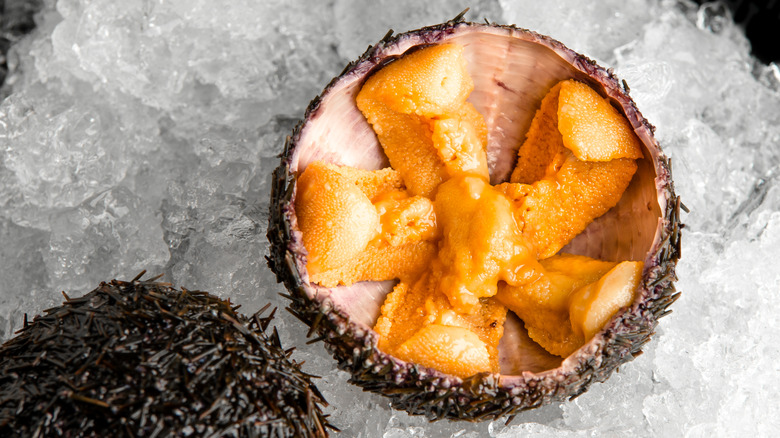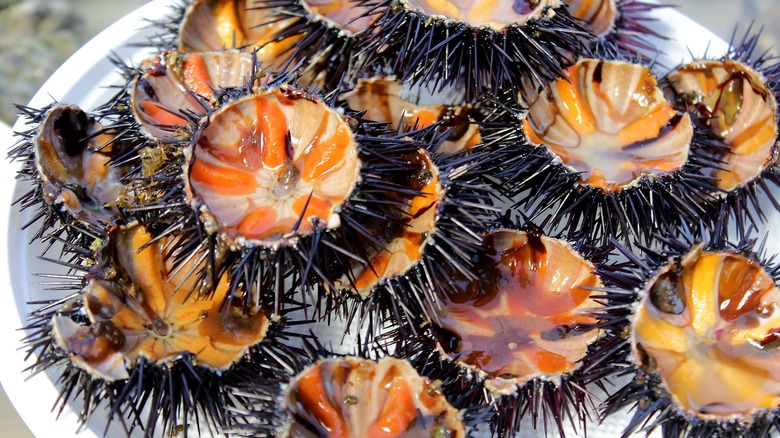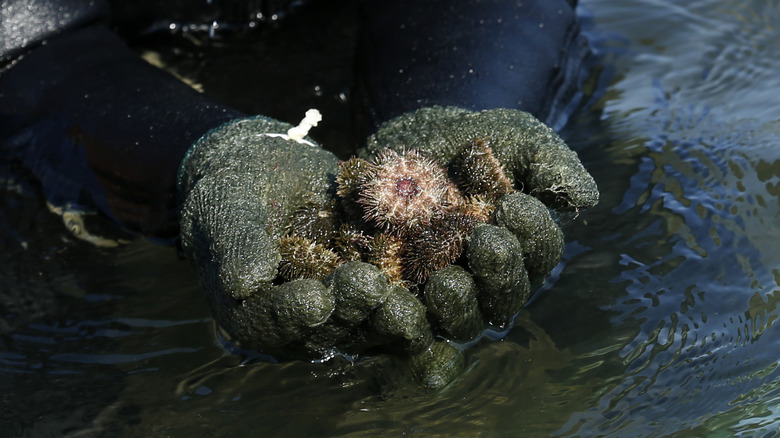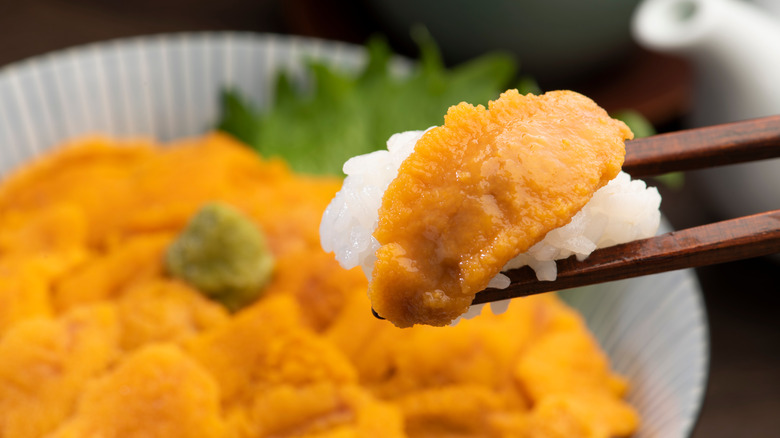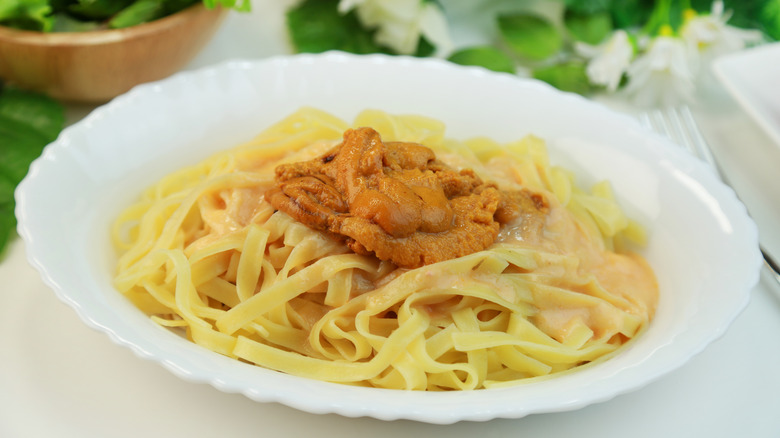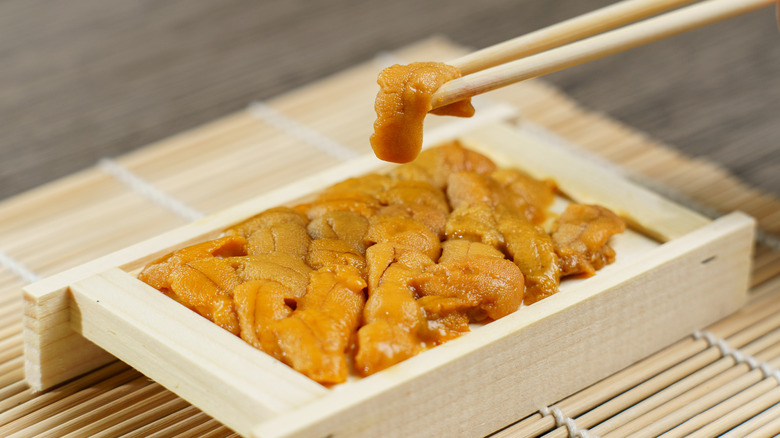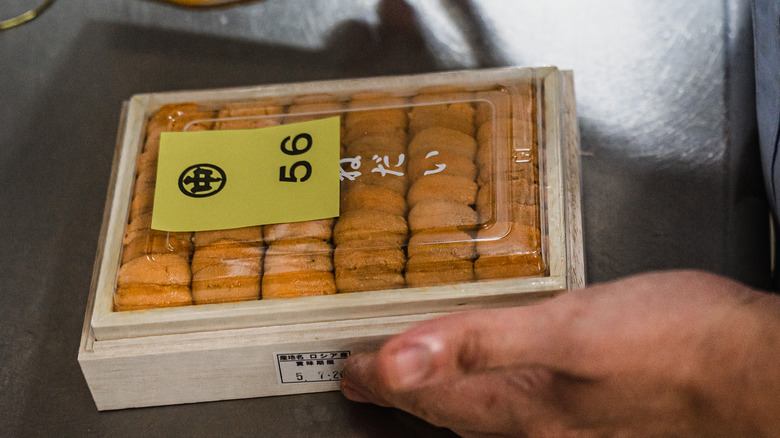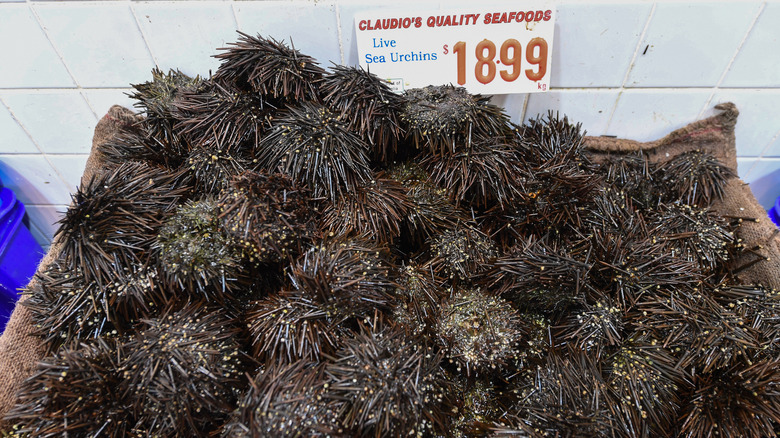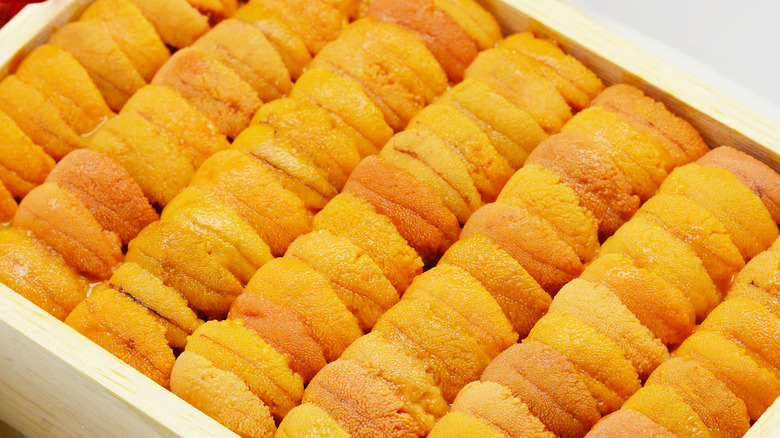What Is Uni And How Do You Cook With It?
If you're a sushi fan, hang out with seafood lovers, or are just beginning to dabble in the world of fine dining, then there's one ingredient you may have heard spoken about with reverence: uni. The late Anthony Bourdain even said that he used uni as a litmus test for dates. "If they did not eat the uni, we will never have a relationship. That's it. It's the end," he shared on the Tokyo episode of Parts Unknown. It's an ingredient that inspires passion, but you might not guess where uni comes from just by looking at it.
That's because, though uni has a soft texture and a hue that varies from pale yellow to bright gold, it actually comes from inside spiky-shelled sea urchins – in the United States, usually Strongylocentrotus fransiscanus, S. drobachiensis, and S. purpuratus. But you shouldn't judge a book by its cover, as any geoduck fan will tell you. The uni inside a sea urchin is prized for its texture and flavor, and it's enjoyed as a delicacy across the world. Ready to dig in? Here's everything you need to know about uni and how to cook with it.
What is uni?
Uni comes from sea urchins. Sea urchins belong to the Echinoidea class of animals along with sand dollars. They are pentaradially symmetry, which means each round critter is split into five symmetrical sections (like starfish). Split a sea urchin open, and you'll see five lobes, sometimes called tongues, inside. That's the uni. Some people will try to tell you that uni is sea urchin roe, but that's actually not quite true. Uni is the sea urchin gonads, which produce roe but are themselves the only edible part of a sea urchin.
Like many products, Uni is graded, though the grading system changes depending on the country. Regardless of location, high-quality uni should have a bright color, a firm and plump texture, and a briny but not fishy scent. Uni is harvested from sea urchins all over the world, especially Chile, California, and Japan. Maine used to have a robust sea urchin fishing industry, but as reported by News Center Maine, the industry dropped off along with the population of green urchins, thanks to habitat loss and climate change. According to the journal Science As a Way of Life, there are 18 sea urchin species used for food. A report by Matis shared that 80–90% of the global supply of uni is consumed by Japan, though it's also popular in the Mediterranean, as well as in the United States, especially in sushi restaurants.
How is uni made?
You can buy uni after it's already been harvested from the sea urchin, or you can buy sea urchins and extract the uni yourself. Commercially, this is how uni is prepared. First, the sea urchins are harvested from the ocean. According to the University of Maine, 60% of sea urchin fishers collect them by hand while scuba diving, using netted bags to carry them back to the surface. Otherwise, sea urchin fishers use drag nets that are swept over the ocean floor, scooping up urchins along the way.
Then, the uni is removed from the sea urchin. If you're at home, you'll need to use a sharp knife or shears to cut out a circle around the sea urchin's mouth. Remove the mouth and the surrounding shell, then drain out the liquid inside, and finally scoop the uni lobes out of the shell and clean them. When you buy boxed uni that's already been removed from the shell, it's already undergone a lengthy process. These sea urchins are processed using special equipment to break into the sea urchin. The uni is removed from the shells by hand, the lobes are rinsed in salt water, and other impurities are removed by hand during multiple rounds of cleaning. The uni is sorted and graded and sometimes gets treated with alum, which helps it retain its firm and juicy texture. The cleaned uni is then packaged for sale. This labor-intensive process is one reason why sea urchin is so expensive.
What does uni taste like?
Uni is prized for its sweet, briny flavor and creamy, custardy mouthfeel. Some people even call uni buttery or compare its texture to a hard-boiled egg yolk. Different grades of uni can have different flavors, and different types of uni, for instance, those from California sea urchins and those from Japanese sea urchins, also have different flavors. This isn't just because they come from different species of sea urchins, but also because those urchins live in different waters and eat different foods. It's similar to how oysters from different areas have different flavor profiles, and in fact, the taste of uni is often compared to oysters or clams.
Uni is most often served raw or gently cooked. It can be folded into risotto and pasta dishes right before serving or stirred into scrambled eggs or ramen. But when uni is cooked for too long, it loses its creamy texture and can become mealy and grainy, and it also tends to take on a flavor similar to cooked fish roe, rather than maintaining its own sweet, briny taste.
How to cook with uni
There are a few different ways that you can cook with uni at home. In general, uni is usually best served raw. This means that especially if you buy uni that's already been harvested from the sea urchin so you don't have to do it yourself, preparing uni at home can be really easy. You can serve uni with rice and a bit of soy sauce on the side, put it on top of good toasted bread, or turn it into uni butter. Uni butter is a blend of uni and butter and can be used in a lot of different ways. Spread on bread, add a dollop on top of a seared steak, or toss with roasted vegetables — the uni butter will add a sweet umami creaminess to any dish.
If you aren't quite taken with the idea of eating raw uni, you can try it gently cooked. Creamy uni pasta dishes are a popular way to enjoy sea urchin, and the uni is usually just tossed with the hot pasta and sauce so it emulsifies and warms up without cooking and getting grainy. Uni that's been finely chopped into a paste can be folded into scrambled eggs right before they set, or added to ramen broth right before serving, to add a creamy umami boost to the meal. In general, you just want to make sure the uni isn't cooked at high heat or for too long, which can ruin its texture and flavor.
Where to buy uni
If you want to try uni, there are a few different places you might be able to buy some. It's often available at the seafood counter in well-stocked and gourmet grocery stores. You might have better success if you have a specific seafood or fish market in your town or city, and Japanese grocery stores with seafood counters are likely to have it as well. You can also order uni online. And, if you live somewhere like Santa Barbara in California, you might even be able to buy sea urchins at the fish markets or at farmer's markets, though you'll likely have to process them yourself.
When purchasing uni, the most important thing to consider is freshness. Fresh uni should look clean and have a briny ocean scent. A bitter or ammonia odor indicates the uni is past its prime. Uni season extends through much of the year, depending on what type of sea urchin you are buying. In general, Japanese uni is in season from late summer through the end of April, Maine sea urchin is in season from September through March, and California sea urchin tends to be in from November through February. When in season, the uni inside each sea urchin is at its plumpest, thanks to the breeding patterns of the urchin. You can still get uni outside of these windows, but like a tomato in winter, it just won't taste as good.
Uni's nutritional information
Sea urchin, known as uni, maybe a prized delicacy, but is it healthy? Fresh sea urchin is full of nutrients, and it's even used to make dietary supplements and medicines. Uni contains substances that an article in the journal Separations says possess anti-oxidant effects, as well as anti-tumor and anti-inflammatory properties. A study published in the Journal of Functional Foods found that when mice were fed a diet high in sea urchin, they had less body, liver, and visceral fat, which led those behind the study to wonder if uni could help prevent fatty liver disease.
However, there are some things to be aware of if you have any dietary health concerns. If you're on a low cholesterol or low sodium diet, you might want to skip uni. One serving of uni has about 200 milligrams of cholesterol, according to Seafood Source, and 200 mg of sodium. The Mayo Clinic recommends skipping foods that contain more than 200 mg of sodium per serving, which means uni is right on the line and is maybe best enjoyed as a "sometimes" food for those watching their sodium intake. As for the cholesterol? If your doctor has told you to eat a low-cholesterol diet, it might be best to avoid uni. That being said, per Healthline, there has been some evidence that the health benefits of cholesterol-containing seafood (like shrimp) outweigh the risks associated with their dietary cholesterol content.
Varieties of uni
There are several varieties of edible sea urchins. In America, there are three main varieties harvested: red, green, and purple. Red urchins are the primary species harvested commercially in California, while green urchins are the specialty of Maine. Then there are purple urchins, which live in great numbers off the west coast. In fact, NPR reports that they're even responsible for the destruction of up to 95% of the kelp forests off the California coast, which has some environmentalists encouraging folks to eat more purple urchins. The only problem there is that, now that their food source has been so depleted, it can be hard to find purple urchins that produce uni that's of a high enough quality and large enough size to be a commercially viable product.
Then, there's Japanese uni. In Japan, the most popular varieties are murasaki and bafun. Murasaki uni is found inside dark purple sea urchins and has a bright yellow color. It's usually eaten raw, due to its delicate flavor and texture. Bafun uni, also called aka uni, is harvested from urchins that live at greater depths in the ocean. The uni has an orange color, and a bolder flavor than murasaki uni, making it a better choice for adding to cooked dishes like pasta or sauces. Of these two varieties, they can be further classified as kita-murasaki and ezo-bafun, meaning they come from the Hokkaido region and are thus more prized.
How to store uni
The most important factor in determining uni's taste and texture is freshness, which means it's important to store it correctly. If uni is stored improperly, it can take on a bitter flavor, or start to smell like ammonia, and the texture can be negatively affected as well. Fresh sea urchins that are still live and whole should be stored in the refrigerator in salt water, covered loosely with a damp towel until you're ready to harvest the uni. They'll usually keep for a few days if you're using this method, and your nose will tell you if they're getting old.
Boxed uni, which is uni that has already been harvested from the urchins and cleaned, is best eaten within two days if it's going to be consumed raw. If it's going to be added to another recipe, it can keep for up to five days. Many chefs swear by ensui uni, which is uni that comes packaged in salt water. This uni is thought to have a sweeter flavor and better texture than uni that's stored dry and can help it taste fresher longer. At the end of the day, the sooner you eat your uni, the better, and considering its prized flavor and texture, it shouldn't be hard to follow that protocol!
